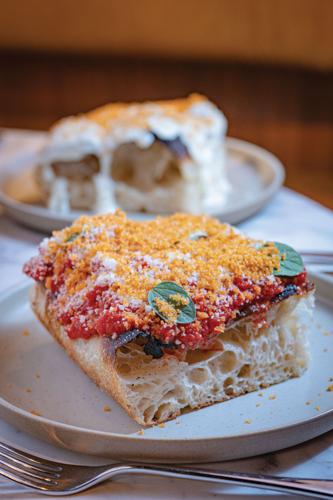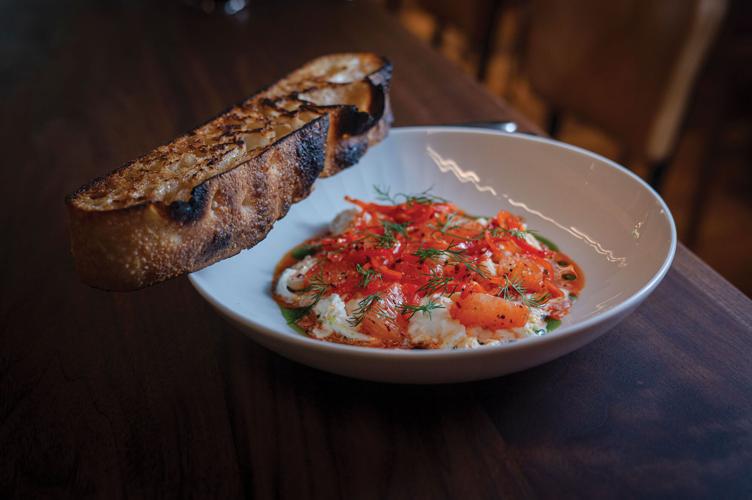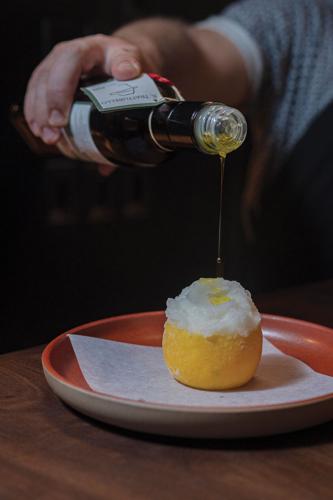Want to start a food fight? Bring up barbecue among Southerners, cheesesteaks to anyone from Philly, hot dogs to Chicagoans.
Want to instigate a full-on verbal war, replete with cussing, colorful insults, vulgar hand gestures, table pounding and self-inflicted head slaps? Mention pizza to a group of Italian American men — particularly those with ties to the Northeast — and let the games begin.
NashTalians can duke it out over Neapolitan, Chicago, Detroit and New York styles. (A moment of silence for Manny’s House of Pizza, which earlier this month announced its closing after a nearly 40-year run of superb pizza and an endless loop of behind-the-counter bickering, led by the legend, Manny Macca.) In a class by itself is a pie that is rectangular like Detroit and thick like Chicago. At Pizza Perfect and NY Pie, it’s on the menu as Sicilian. Inarguably, there is only one restaurant in Nashville that calls it by its rightful name — sfincione, a term also inarguably less familiar than Sicilian and harder to pronounce. (According to my exhaustive internet search, it’s sfeen-CHO-neh.)
St. Vito Focacceria is spelled out on individual gold-metal letters mounted on the side of the russet-painted section of a cinderblock building in a less-traveled pocket of the Gulch. But immediately inside the glass door, a rectangular lit sign hung from the ceiling, with bold red letters proclaiming “SFINCIONE TO GO,” announces the main attraction. Beneath it is the small cocktail/wine/beer bar, which doubles as a pickup station. On the left wall, a bookcase is crammed with cookbooks, including the one — Made in Sicily by Giorgio Locatelli — that set St. Vito chef-owner Michael Hanna on the path to this interpretive expression of his heritage. At St. Vito, he simultaneously pays homage to the centuries-old recipe established in Sicily’s capital Palermo and puts a personal, contemporary spin on the composition.
Hanna is a mash-up of Sicilian maternal lineage, decades of family-owned restaurants and his own experience in kitchens ranging from meticulous, high-end, multicourse tweezer food at The Catbird Seat, to rustic peasant fare at Philip Krajeck’s Rolf and Daughters and Folk.
While furloughed by COVID, Hanna was flipping through Made in Sicily; the chapter on sfincione tapped into forgotten memories of eating it as a child, and it clicked. It’s all about the bread.
Historically, sfincione traces its roots back to the 17th century, when the nuns in the small St. Vito monastery created the original recipe of bread, bechamel, chicken offal and peas. Chefs for an Italian prince in a small village outside Palermo replaced bechamel with cheese, and chicken and peas with sardines. Through the years, it morphed and developed into a home-cook and street-food dish with tomatoes, anchovies and onions.
Hanna got to work, developing a bread that leans more to Spanish ciabatta and is 100 percent hydrated, naturally leavened and fermented through a long, cold bulk method; he adds that his dough has a high percentage of oil and a little sugar. He experimented with sheet trays of the bread, adding cubes of fontina cheese to the dough before baking. He saw the bread as a canvas and began adding simple toppings. With encouragement from chef friends Trevor Moran, Andy Little and Tom Bayless, he created an Instagram account, started online sales through direct-message ordering and Venmo payments, with evening pickups at his house.

Classic Vito
As literal word of mouth drove demand for his sfincione, he moved to a commissary kitchen at Hunters Station, then a small space at the Van Dyke, and penultimately a weekly Sunday night takeover at Hathorne. He was approached by investors who didn’t work out, had a lease snatched away and lost funding until finally the right partner emerged, they found a space, and on May 24, opened St. Vito Focacceria.
The shotgun space is intimate and warmly lit with 13 comfortable swivel seats (with backs!) snug to a walnut bar overlooking the kitchen on one side; a long wood-and-fabric upholstered banquette fronted with marble-topped tables adds seating for 30 more on the other. Green lamps mounted on the wall illuminate brass-lion-head wallpaper that looks as if it belongs in an ornate Italian drawing room.
Through multiple iterations, Hanna has settled on a menu of plates, sfincione and dolce, where pastry chef Mayme Gretsch plays.
Because plates lead the menu, you might start there, as we did. With seven to choose from, we selected the marinated zucchini, fresh peaches, hand-pulled mozzarella, Caesar salad and eggplant caponata. On the vegetable and fruit plates, the title produce — sourced primarily from Harpeth Moon Farm in Kingston Springs — was center stage, complemented and enhanced by complex preparations of vinaigrettes, sauces and supporting accoutrements. For instance, the Calabrian vinaigrette inspired by a Thai laab dressing, pistachios and huckleberries with the charred zucchini; the Alabama peaches soaked in moscato d’Asti sparkling wine, barely visible under a blizzard of shaved aged Gouda; and the bowl of cold, cooked eggplant with confited lobster mushrooms, olives and intensely flavored tomato agrodolce made with sun-dried tomato paste.
Unfortunately, none of those dishes remain on the menu thanks to Hanna’s devotion to regional and seasonal availability, but I feel confident assuring future diners that whatever replaces them will be equally thoughtful, impressive and memorable. The mozzarella has been switched out to stracciatella, sometimes still presented with basil pesto, a ring of bay/parsley/basil oil, and toasted focaccia.

Stracciatella, acqua di peperoncino, grapefruit, toasted focaccia
The Classic Vito and the potato sfincione will always be on the menu, and we tried a slice of each. Every sfincione is finished with a generous toss of breadcrumbs — panko fried in olive oil, seasoned with dried herbs, salt, pepper and dehydrated garlic and a heavy grate of pecorino. There was no argument in our foursome over our favorite; the Stanislaus canned California pear tomatoes milled in house had the perfect trace of sweetness and pure essence of sun-ripened tomato and needed nothing more but the little leaves of fresh oregano scattered atop. The bread is crisped on the bottom and sides, light and chewy inside and studded with melted fontina cheese.
On the other hand, we clearly disagreed with the two men seated beside us, who practically came to blows over the last bite of their potato sfincione, which our server also told us was his favorite. The creamy, thick potato sauce is a technique Hanna first learned at Catbird before working out this version, which reminded us of Alfredo sauce. Basically, cooked potatoes are puréed with heated, emulsified cream, garlic, preserved lemon, a small amount of cream cheese, black pepper and salt, then poured over the bread, strewn with those delicious breadcrumbs. We found no fault with the flavor, but the combo of potato, cream, cheese and bread was too heavy for our taste.
We recovered with Gretsch’s weightless, pristine sorbetto di limone, lightly kissed with wild vanilla and served in a hollowed-out frozen lemon.
As we left St. Vito, the famous line from the Godfather popped into my head. “Leave the gun, take the cannoli.” When it comes to Michael Hanna’s jewel box of a restaurant, I would paraphrase: Come for the sfincione, stay for the plates, and for God’s sake, don’t leave without at least one lemon sorbet.

sorbetto di limone




